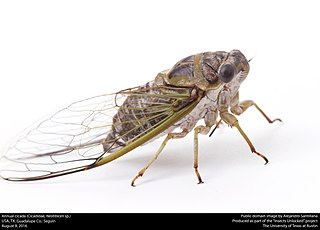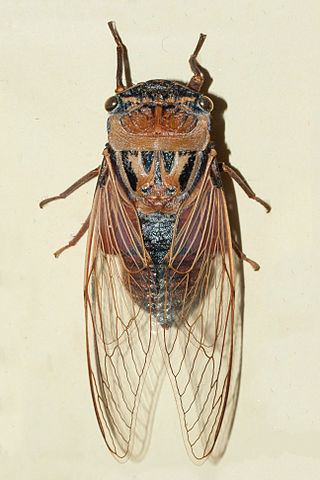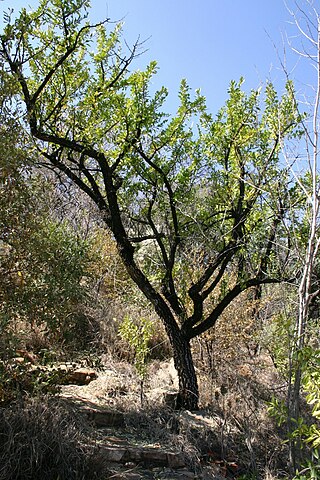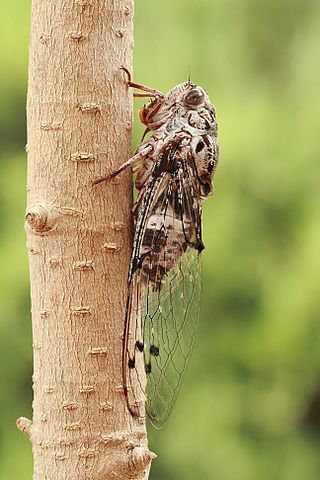
The cicadas are a superfamily, the Cicadoidea, of insects in the order Hemiptera. They are in the suborder Auchenorrhyncha, along with smaller jumping bugs such as leafhoppers and froghoppers. The superfamily is divided into two families, the Tettigarctidae, with two species in Australia, and the Cicadidae, with more than 3,000 species described from around the world; many species remain undescribed. Nearly all of cicada species are annual cicadas with the exception of the few North American periodical cicada species, genus Magicicada, which in a given region emerge en masse every 13 or 17 years.

The term periodical cicada is commonly used to refer to any of the seven species of the genus Magicicada of eastern North America, the 13- and 17-year cicadas. They are called periodical because nearly all individuals in a local population are developmentally synchronized and emerge in the same year. Although they are sometimes called "locusts", this is a misnomer, as cicadas belong to the taxonomic order Hemiptera, suborder Auchenorrhyncha, while locusts are grasshoppers belonging to the order Orthoptera. Magicicada belongs to the cicada tribe Lamotialnini, a group of genera with representatives in Australia, Africa, and Asia, as well as the Americas.

Cicadidae, the true cicadas, is one of two families of cicadas, containing almost all living cicada species with more than 3,200 species worldwide.

Kevin Volans is a South African born Irish composer and pianist. He studied with Karlheinz Stockhausen and Mauricio Kagel in Cologne in the 1970s and later became associated with the Neue Einfacheit movement in the city. In the late 1970s he became interested in the indigenous music of his homeland and began a series of pieces which attempted to combine aspects of African and contemporary European music. Although Volans later moved away from any direct engagement with African music, certain residual elements such as interlocking rhythms, repetition and open forms are still detectable in his music since the early 1990s which takes a new direction more redolent of certain schools of abstract art. He settled in Ireland permanently in 1986 and was granted Irish citizenship in 1994.

Cicada killer wasps are large, solitary, ground-dwelling, predatory wasps. They are so named because they hunt cicadas and provision their nests with them, after stinging and paralyzing them. Twenty-one species worldwide are recognized. The highest diversity occurs in the region between North Africa and Central Asia.
In biology, exuviae are the remains of an exoskeleton and related structures that are left after ecdysozoans have molted. The exuviae of an animal can be important to biologists as they can often be used to identify the species of the animal and even its sex.

The Cicadinae are a subfamily of cicadas, containing the translucent cicadas. They are robust cicadas and many have gaudy colors, but they generally lack the butterfly-like opaque wing markings found in many species of the related Tibiceninae.

Thopha saccata, the double drummer, is the largest Australian species of cicada and reputedly the loudest insect in the world. Documented by the Danish zoologist Johan Christian Fabricius in 1803, it was the first described and named cicada native to Australia. Its common name comes from the large dark red-brown sac-like pockets that the adult male has on each side of its abdomen—the "double drums"—that are used to amplify the sound it produces.

Platypleura divisa is an African cicada first described by Ernst Friedrich Germar, entomologist and professor of mineralogy at Halle, who also studied beetles.

Platypleura is a genus of cicadas that occurs widely across Africa and southern Asia. Some of the South African species are remarkable for their endothermic thermoregulation that enables crepuscular signalling, an adaptation that reduces risk of predation and enables a greater range for their calls. In field experiments their maximum body temperature while calling at dusk, was measured at 22 °C above ambient temperature.

Gymnosporia heterophylla, the common spike-thorn, is a small, hardy, deciduous African tree up to 5m tall, occurring in rocky places with a wide distribution from Ethiopia, the Sudan and the Congo, south to the Cape Province and west to Angola and Namibia, as well as the neighbouring islands of Madagascar and Saint Helena, with a closely related species from Mauritius.

Aleeta is a genus of cicadas with the only species Aleeta curvicosta, one of Australia's most familiar insects. Native to the continent's eastern coastline, it was described in 1834 by Ernst Friedrich Germar.
Orachrysops mijburghi, the Mijburgh's blue, is a butterfly of the family Lycaenidae. It is found in South Africa, where it is known from highland grassveld in the Free State.
In the 10th edition of Systema Naturae, Carl Linnaeus classified the arthropods, including insects, arachnids and crustaceans, among his class "Insecta". True bugs and thrips were brought together under the name Hemiptera.

Platypleura sylvia is a species of cicada endemic to South Africa. It was first described and named by William Lucas Distant in 1899 in the Annals and Magazine of Natural History. Insecta transvaaliensia was self-published by Distant and appeared in twelve parts over the period 1900-1911. The series was an account of Distant's insect-collecting trips through the Transvaal. The collected parts were published as a single volume after Distant's death by Francis Edwards of London in 1924.

Cicada 3301 is the name given to three sets of puzzles posted under the name "3301" online between 2012 and 2014. The first puzzle started on January 4, 2012, on 4chan and ran for nearly a month. A second round of puzzles began one year later on January 4, 2013, and then a third round following the confirmation of a fresh clue posted on Twitter on January 4, 2014. The third puzzle remains unsolved. The stated intent was to recruit "intelligent individuals" by presenting a series of puzzles to be solved; no new puzzles were published on January 4, 2015. A new clue was posted on Twitter on January 5, 2016. Cicada 3301 posted their last verified OpenPGP-signed message in April 2017, denying the validity of any unsigned puzzle.

Pycna is a genus of cicadas from Africa and Asia.

The Platypleurini are a tribe of cicadas from the Afrotropical and Oriental regions There are at least 30 genera and 240 described species in Platypleurini.

Platypleura haglundi is a medium-sized African cicada species, that occurs from northern South Africa to Zimbabwe, where it is found in diverse habitats. In South Africa it has been recorded in North West, the northern Free State, Northern Province, Gauteng, Mpumalanga and Kwazulu-Natal. The type was collected in Weenen Game Reserve, KwaZulu-Natal.

Rhipiceridae is a family of beetles found worldwide. The larva of rhipicerids are parasitoids of cicada nymphs. Rhipiceridae and Dascillidae form the super family Dascilloidea, within the Elateriformia.
















